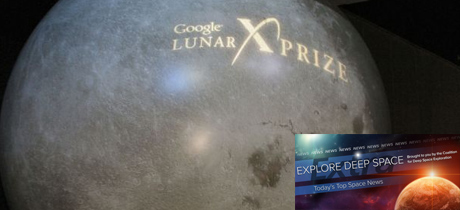In Today’s Deep Space Extra… NASA resumes its U.S. government operations with a previously scheduled spacewalk by two astronauts outside the International Space Station. NASA’s Parker Solar Probe to take closest look ever at the sun. Future of Google Lunar X Prize appears to dim, but U.S. companies eager to explore the moon.
Human Space Exploration
End to government shutdown should limit impact on space operations
Spacepolicyonline.com (1/22): U.S. government agencies were poised to resume normal workforce activities on Tuesday, among them NASA with operations that included a spacewalk by astronauts Mark Vande Hei and Scott Tingle outside the International Space Station. During the six to seven hour excursion, expected to get underway about 7 a.m., EST, the two men are to continue efforts initiated in October to upgrade the station’s Canadian robot arm. NASA was committed to carrying out the spacewalk even with the government shutdown that went into effect last Friday at midnight. On Tuesday, the Senate and House voted on legislation restoring government operations through February 8. President Trump then signed the measure.
How to reduce U.S. space expenses through competitive and cooperative approaches
The Space Review (1/22): Strong U.S. leadership can opens doors to global cooperation in the exploration of space and cost savings, writes Takuya Wakimoto, a graduate student at the Space Policy Institute, of George Washington University.
Space Science
A changing of the guard in NASA’s hunt for exoplanets
Space News (1/22): The Kepler space telescope, launched by NASA in 2009 and productive in its search for extra solar planets despite technical difficulties, is now running low on fuel and expected to cease operations later this year. Its replacement, the Transiting Exoplanet Survey Satellite, is expected to launch this spring.
In the search for alien life, ‘everyone is an astrobiologist’
Space.com (1/22): Mary Voytek, is NASA’s senior scientist for astrobiology, the study of the basis for and possible existence of life beyond Earth. The field is maturing, with no lack of scientific disciplines with the credentials to make contributions, Voytek explained at a professional gathering at the University of California, Irving, last week.
Upcoming telescopes should be able to detect mountains and other landscape on extrasolar Planets
Universe Today (1/22): The Transit Method, a productive observing technique for detecting the presence of extra solar planets by the dimming of host stars as planets pass in front and made famous by NASA’s Kepler space telescope, has new promise. The technique should be able to detect small variations in brightness that correspond to major geological features like mountain ranges on planets beyond the solar system.
This NASA spacecraft will get closer to the sun than anything ever before
Washington Post (1/22): Long a NASA science objective, a close-up look at the sun is the goal of NASA’s Parker Solar Probe, which could be launched this summer. The probe is designed to skim through the sun’s atmosphere at 450,000 miles per hour and seven times closer than any spacecraft predecessor.
Triple treat: Supermoon, blue moon and lunar eclipse all coming to a sky near you next week
USA Today (1/22): All are rare: a supermoon, blue moon and lunar eclipse. But all of the phenomena in one night — that’s even rarer. That’s what’s to happen in the darkness of January 31. The U.S. West Coast will offer the best view in skies. Skies over the central and eastern U.S. will gaze at only a partial eclipse. The moon for them will set before it reaches totality.
Other News
Space industry hit hard by military spending downturn
Space News (1/22): A downturn in military spending, initiated in 2010, is taking a financial toll on the U.S. space industry, according to a study from the Center for Strategic and International Studies. Among the findings, Pentagon contract awards for space systems totaling nearly $10 billion in 2009 have fallen to just over $6 billion in 2016.
Moon ambitions get a reality check, plus a boost from Apollo moonshot memories
Geek Wire (1/22): Google Lunar X Prize has no further plans to extend its $20 million prize offering to the first company to land on the lunar surface and perform operations beyond March 31, CNBC reports. The deadline for the prize, first announced in 2007, has been extended several times. Five of more than 30 teams that registered for the prize, remained in the competition, including the U.S. companies Moon Express and Synergy Moon. However, the Trump administration’s lunar surface initiative, announced last year, has some in the U.S. private sector making plans to participate, among them Bigelow Aerospace, Blue Origin, United Launch Alliance and SpaceX.
Small rockets are finally taking off, but will the market follow?
The Space Review (1/22): The first successful launch of Rocket Lab’s Electron rocket signals a coming wave of new small launch vehicles tailored specifically to carry small satellites as their primary payloads. Virgin Orbit is right behind. The challenge they face is whether they are outpacing a market used to launching small satellites as secondary payloads.
SpaceX, Blue Origin have Florida’s Space Coast poised for change
Orlando Sentinel (1/22): Florida’s Atlantic Coast has witnessed growing launch activity from United Launch Alliance (ULA) and SpaceX. But more economic activity is on the way, prompted by the recent construction of a Blue Origin rocket manufacturing facility and a surge in the wider production and launch of small satellites. Space Florida, the state economic development agency and a catalyst for the new economic growth, predicts more of the same as the year unfolds.

